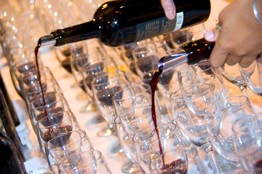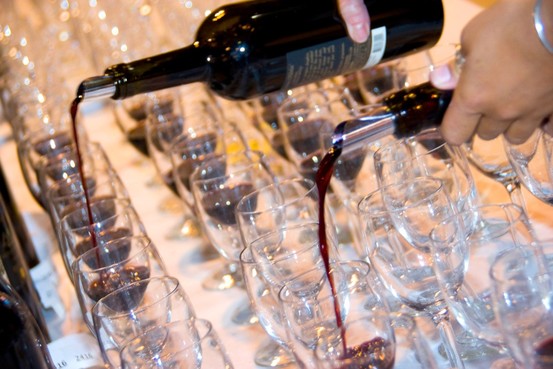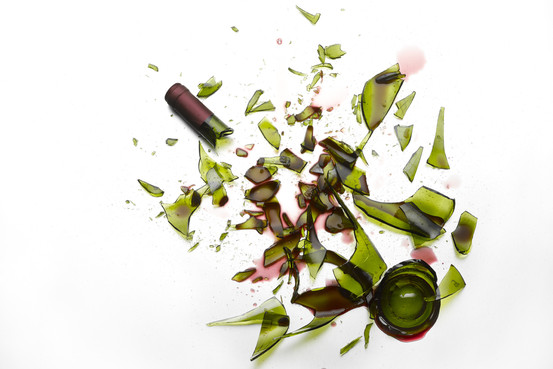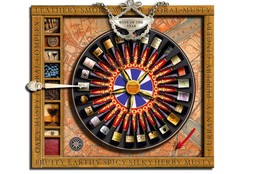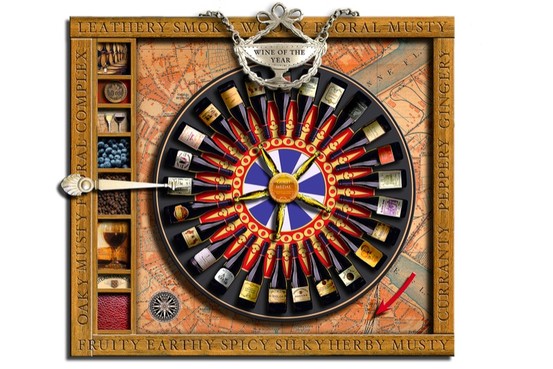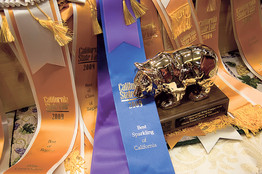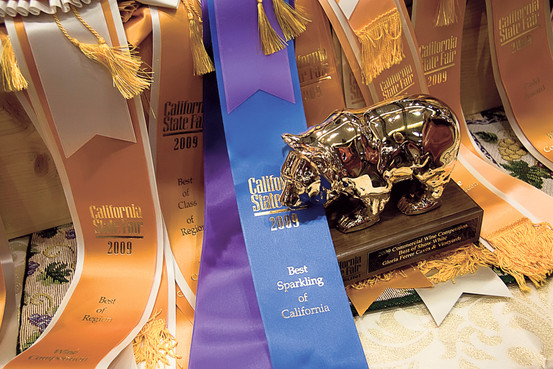more evidence for my deeply held beliefs about *contests*
a very good read....
http://online.wsj.com/article/SB10001424052748703683804574533840282653628.html
<h1>A Hint of Hype, A Taste of Illusion
</h1><h2 ="sub">They pour, sip and, with passion and snobbery,
glorify or doom wines. But studies say the wine-rating system is badly
flawed. How the experts fare against a coin toss.</h2>
<h3 ="byline">By
LEONARD MLODINOW </h3>
Acting
on an informant's tip, in June 1973, French tax inspectors barged into
the offices of the 155-year-old Cruse et Fils Frères wine shippers.
Eighteen men were eventually prosecuted by the French government,
accused, among other things, of passing off humble wines from the
Languedoc region as the noble and five-times-as-costly wine of
Bordeaux. During the trial it came out that the Bordeaux wine merchants
regularly defrauded foreigners. One vat of wine considered extremely
inferior, for example, was labeled "Salable as Beaujolais to
Americans."
<div ="insetContent insetCol3wide - at-D"><div ="insetTree">
<div id="articleThumbnail_1" ="insettipUnit insetZoomTarget"><div ="insetZoomTarget"><div ="insettip"><div ="insettip">
<a>View Full Image</a><a>
</a>
<cite>Tia Gemmell/California State Fair</cite>
Wines are poured at the California State Fair wine competition in June 2008.
<div style="visibility: ;" id="article_1" ="insetFullBracket"><div ="insetFull"><div ="inset"><a ="inset">
</a>
It
was in this climate that in the 1970s a lawyer-turned-wine-critic named
Robert M. Parker Jr. decided to aid consumers by assigning wines a
grade on a 100-point scale. Today, critics like Mr. Parker exert
enormous influence. The medals won at the 29 major U.S. wine
competitions medals are considered so influential that wineries spend
well over $1 million each year in entry fees. According to a 2001 study
of Bordeaux wines, a one-point bump in Robert Parker's wine ratings
averages equates to a 7% increase in price, and the price difference
can be much greater at the high end.
Given the high price of wine and the enormous number of choices, a
system in which industry experts comb through the forest of wines,
judge them, and offer consumers the meaningful shortcut of medals and
ratings makes sense.
But what if the successive judgments of the same wine, by the same
wine expert, vary so widely that the ratings and medals on which wines
base their reputations are merely a powerful illusion? That is the
conclusion reached in two recent papers in the Journal of Wine
Economics.
Both articles were authored by the same man, a unique blend of
winemaker, scientist and statistician. The unlikely revolutionary is a
soft-spoken fellow named Robert Hodgson, a retired professor who taught
statistics at Humboldt State University. Since 1976, Mr. Hodgson has
also been the proprietor of Fieldbrook Winery, a small operation that
puts out about 10 wines each year, selling 1,500 cases
A few years ago, Mr. Hodgson began wondering how wines, such as his
own, can win a gold medal at one competition, and "end up in the
pooper" at others. He decided to take a course in wine judging, and met
G.M "Pooch" Pucilowski, chief judge at the California State Fair wine
competition, North America's oldest and most prestigious. Mr. Hodgson
joined the Wine Competition's advisory board, and eventually "begged"
to run a controlled scientific study of the tastings, conducted in the
same manner as the real-world tastings. The board agreed, but expected
the results to be kept confidential.
There is a rich history of scientific research questioning whether
wine experts can really make the fine taste distinctions they claim.
For example, a 1996 study in the Journal of Experimental Psychology
showed that even flavor-trained professionals cannot reliably identify
more than three or four components in a mixture, although wine critics
regularly report tasting six or more. There are eight in this
description, from The Wine News, as quoted on wine.com, of a Silverado
Limited Reserve Cabernet Sauvignon 2005 that sells for more than $100 a
bottle: "Dusty, chalky scents followed by mint, plum, tobacco and
leather. Tasty cherry with smoky oak accents…" Another publication, The
Wine Advocate, describes a wine as having "promising aromas of
lavender, roasted herbs, blueberries, and black currants." What is
striking about this pair of descriptions is that, although they are
very different, they are descriptions of the same Cabernet. One taster
lists eight flavors and scents, the other four, and not one of them
coincide.
<div ="insetContent insetCol3wide - at-D"><div ="insetTree">
<div id="articleThumbnail_2" ="insettipUnit insetZoomTarget"><div ="insetZoomTarget"><div ="insettip"><div ="insettip">
<a>View Full Image</a><a>
</a>
<cite>Photo illustration by Donna Kugleman/The Wall Street Journal; Getty Images (bottle); Alamy (puddle)</cite>
A smashed red wine bottle on white background.
<div style="visibility: ;" id="article_2" ="insetFullBracket"><div ="insetFull"><div ="inset"><a ="inset">
</a>
That
wine critiques are peppered with such inconsistencies is exactly what
the laboratory experiments would lead you to expect. In fact, about 20
years ago, when a Harvard psychologist asked an ensemble of experts to
rank five wines on each of 12 characteristics—such as tannins,
sweetness, and fruitiness—the experts agreed at a level significantly
better than chance on only three of the 12.
Psychologists have also been skeptical of wine judgments because
context and expectation influence the perception of taste. In a 1963
study at the University of California at Davis, researchers secretly
added color to a dry white wine to simulate a sauterne, sherry, rosé,
Bordeaux and burgundy, and then asked experts to rate the sweetness of
the various wines. Their sweetness judgments reflected the type of wine
they thought they were drinking. In France, a decade ago a wine
researcher named Fréderic Brochet served 57 French wine experts two
identical midrange Bordeaux wines, one in an expensive Grand Cru
bottle, the other accommodated in the bottle of a cheap table wine. The
gurus showed a significant preference for the Grand Cru bottle,
employing adjectives like "excellent" more often for the Grand Cru, and
"unbalanced," and "flat" more often for the table wine.
Provocative as they are, such studies have been easy for wine
critics to dismiss. Some were small-scale and theoretical. Many were
performed in artificial laboratory conditions, or failed to control
important environmental factors. And none of the rigorous studies
tested the actual wine experts whose judgments you see in magazines and
marketing materials. But Mr. Hodgson's research was different.
<div ="insetContent insetCol3wide - at-D"><div ="insetTree">
<div id="articleThumbnail_3" ="insettipUnit insetZoomTarget"><div ="insetZoomTarget"><div ="insettip"><div ="insettip">
<a>View Full Image</a><a>
</a>
<cite>Chris Wadden</cite>
<div style="visibility: ;" id="article_3" ="insetFullBracket"><div ="insetFull"><div ="inset"><a ="inset">
</a>
In
his first study, each year, for four years, Mr. Hodgson served actual
panels of California State Fair Wine Competition judges—some 70 judges
each year—about 100 wines over a two-day period. He employed the same
blind tasting process as the actual competition. In Mr. Hodgson's
study, however, every wine was presented to each judge three different
times, each time drawn from the same bottle.
The results astonished Mr. Hodgson. The judges' wine ratings
typically varied by ±4 points on a standard ratings scale running from
80 to 100. A wine rated 91 on one tasting would often be rated an 87 or
95 on the next. Some of the judges did much worse, and only about one
in 10 regularly rated the same wine within a range of ±2 points.
Mr. Hodgson also found that the judges whose ratings were most
consistent in any given year landed in the middle of the pack in other
years, suggesting that their consistent performance that year had
simply been due to chance.
Mr. Hodgson said he wrote up his findings each year and asked the
board for permission to publish the results; each year, they said no.
Finally, the board relented—according to Mr. Hodgson, on a close
vote—and the study appeared in January in the Journal of Wine
Economics.
"I'm happy we did the study," said Mr. Pucilowski, "though I'm not
exactly happy with the results. We have the best judges, but maybe we
humans are not as good as we say we are."
This September, Mr. Hodgson dropped his other bombshell. This time,
from a private newsletter called The California Grapevine, he obtained
the complete records of wine competitions, listing not only which wines
won medals, but which did not. Mr. Hodgson told me that when he started
playing with the data he "noticed that the probability that a wine
which won a gold medal in one competition would win nothing in others
was high." The medals seemed to be spread around at random, with each
wine having about a 9% chance of winning a gold medal in any given
competition.
To test that idea, Mr. Hodgson restricted his attention to wines
entering a certain number of competitions, say five. Then he made a bar
graph of the number of wines winning 0, 1, 2, etc. gold medals in those
competitions. The graph was nearly identical to the one you'd get if
you simply made five flips of a coin weighted to land on heads with a
probability of 9%. The distribution of medals, he wrote, "mirrors what
might be expected should a gold medal be awarded by chance alone."
Mr. Hodgson's work was publicly dismissed as an absurdity by one
wine expert, and "hogwash" by another. But among wine makers, the
reaction was different. "I'm not surprised," said Bob Cabral, wine
maker at critically acclaimed Williams-Selyem Winery in Sonoma County.
In Mr. Cabral's view, wine ratings are influenced by uncontrolled
factors such as the time of day, the number of hours since the taster
last ate and the other wines in the lineup. He also says critics taste
too many wines in too short a time. As a result, he says, "I would
expect a taster's rating of the same wine to vary by at least three,
four, five points from tasting to tasting."
<div ="insetContent insetCol3wide - at-D"><div ="insetTree">
<div id="articleThumbnail_4" ="insettipUnit insetZoomTarget"><div ="insetZoomTarget"><div ="insettip"><div ="insettip">
<a>View Full Image</a><a>
</a>
<cite>Tia Gemmell/California State Fair</cite>
Ribbons from the 2009 California State Fair wine competition.
<div style="visibility: ;" id="article_4" ="insetFullBracket"><div ="insetFull"><div ="inset"><a ="inset">
</a>
Francesco
Grande, a vintner whose family started making wine in 1827 Italy, told
me of a friend at a well-known Paso Robles winery who had conducted his
own test, sending the same wine to a wine competition under three
different labels. Two of the identical samples were rejected, he said,
"one with the comment 'undrinkable.' " The third bottle was awarded a
double gold medal. "Email Robert Parker," he suggested, "and ask him to
submit to a controlled blind tasting."
I did email Mr. Parker, and was amazed when he responded that he,
too, did not find Mr. Hodgson's results surprising. "I generally stay
within a three-point deviation," he wrote. And though he didn't agree
to Mr. Grande's challenge, he sent me the results of a blind tasting in
which he did participate.
The tasting was at Executive Wine Seminars in New York, and
consisted of three flights of five wines each. The participants knew
they were 2005 Bordeaux wines that Mr. Parker had previously rated for
an issue of The Wine Advocate. Though they didn't know which wine was
which, they were provided with a list of the 15 wines, with Mr.
Parker's prior ratings, according to Executive Wine Seminars' managing
partner Howard Kaplan. The wines were chosen, Mr. Kaplan says, because
they were 15 of Mr. Parker's highest-rated from that vintage.
Mr. Parker pointed out that, except in three cases, his second
rating for each wine fell "within a 2-3 point deviation" of his first.
That's less variation than Mr. Hodgson found. One possible reason: Mr.
Parker's first rating of all the wines fell between 95 and 100—not a
large spread.
One critic who recognizes that variation is an issue is Joshua
Greene, editor and publisher of Wine and Spirits, who told me, "It is
absurd for people to expect consistency in a taster's ratings. We're
not robots." In the Cruse trial, the company appealed to the idea that
even experienced tasters could err. Cruse claimed that it had bought
the cheap Languedoc believing it was the kingly Bordeaux, and that the
company's highly-trained and well-paid wine tasters had failed to
perceive that it wasn't. The French rejected that possibility, and 35
years ago this December, eight wine dealers were convicted and given
prison terms and fines totaling $8 million.
Despite his studies, Mr. Hodgson is betting that, like the French,
American consumers won't be easily converted to the idea that wine
experts are fallible. His winery's Web site still boasts of his own
many dozens of medals.
"Even though ratings of individual wines are meaningless, people
think they are useful," Mr. Greene says. He adds, however, that one can
look at the average ratings of a spectrum of wines from a certain
producer, region or year to identify useful trends.
As a consumer, accepting that one taster's tobacco and leather is
another's blueberries and currants, that a 91 and a 96 rating are
interchangeable, or that a wine winning a gold medal in one competition
is likely thrown in the pooper in others presents a challenge. If you
ignore the web of medals and ratings, how do you decide where to spend
your money?
One answer would be to do more experimenting, and to be more
price-sensitive, refusing to pay for medals and ratings points. Another
tack is to continue to rely on the medals and ratings, adopting an
approach often attributed to physicist Neils Bohr, who was said to have
had a horseshoe hanging over his office door for good luck. When asked
how a physicist could believe in such things, he said, "I am told it
works even if you don't believe in it." Or you could just shrug and
embrace the attitude of Julia Child, who, when asked what was her
favorite wine, replied "gin."
As for me, I have always believed in the advice given by famed food
critic Waverly Root, who recommended that one simply "Drink wine every
day, at lunch and dinner, and the rest will take care of itself."
<cite ="tagline">—Leonard Mlodinow teaches randomness at Caltech. His most recent book is "The Drunkard's Walk: How Randomness Rules Our Lives."</cite>












